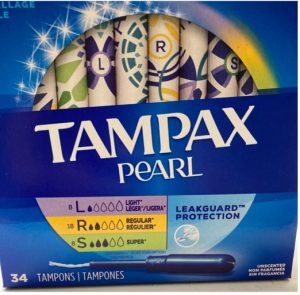Before taking an intellectual property (IP) course this past fall, I assumed trademarks only applied to brand slogans. I did not realize that trademarks could apply to physical products, too.
Now that I have taken various IP courses and participated in the IP Moot Court team, I see trademark protection everywhere. This made me wonder: can a commonplace item, like an applicator for a tampon, receive trade dress protection?
Before jumping into that answer, let’s first explain what a trade dress is.
What is a trade dress?
Trade dress is a form of trademark protection. When we think of trademarks, we tend to think of words, logos, or symbols that serve as source identifiers for consumers. For example, when we hear “Eat Fresh” we think of Subway’s slogan. Similarly, when we see an apple with a bite out of it, we think of Apple tech products. Even names, like Google, make us think of the search engine.
The dress or appearance of an item, too, can receive trademark protection. Both trademarks and trade dress are covered by the Lanham Act which forms the federal basis for our current trademark jurisprudence. Trade dress specifically protects the dress, or appearance, of an object. Companies value trade dress as a way to distinguish themselves from other products.
In order for the dress or design of an item to receive protection, it needs to be used on goods or services in commerce to identify the source of the product and it cannot be functional. While it’s more obvious when something is in commerce, it may be harder to know what it means to “identify” the source or not be “functional.” Read on to learn what it means to identify the source (also known as being distinctive) and be functional!
Is a tampon applicator distinctive?
A product design or packaging is distinctive if consumers look at the product and identify that product with the brand. Generally, the more unique the product, the more distinct it is. That may seem straightforward, but there are additional rules about distinctiveness of trade dress that complicate things.
Trade dress can either protect the design of a product or the product’s packaging. The design may be the specific color of a product or the patterns; or, it could be the shape of the product. Packaging refers to the external wrapping of a product, such as a wrapper for a lollipop.

For a tampon or tampon applicator, the packaging of the tampons – the color of the box and the design on the box – counts as product packaging. Additionally, the applicator for a tampon is the package that a tampon comes in. The tampon applicator then, as a package for the tampon, is inherently distinctive. When something is inherently distinctive, consumers do not need to associate the packaging with the brand in particular in order for the packaging to receive trade dress protection.
Product design, however, needs “secondary meaning”. The red sole of a Louboutin shoe needed to acquire secondary meaning, or consumer recognition, in order to have distinctiveness and association with the Louboutin brand. Without secondary meaning, it is just a red sole that doesn’t identify one manufacturer. Only once consumers start associating red soles with Louboutin can that shoe meet the distinct threshold and qualify for trade dress protection. In contrast, consumers do not associate all red high heel shoes (i.e., not just the red sole) with this company; so, Louboutin does not have secondary meaning for entirely red shoes.
Products can sometimes be protected by both trade dress design and packaging. For example, Coca-Cola bottles are both product packaging – what their product, the coke, is in – and product design – consumers may collect bottles or like the aesthetic look. Similarly, a tampon applicator both packages the actual tampon and could be a design in itself. Likely, though, consumers are not collecting tampon applicators like they are coke bottles. In instances where a product could be either a package or design, courts generally err on the side of caution and require secondary meaning.
So, for a tampon applicator to be distinctive, consumers would need to associate that particular applicator with a brand. When people see a plastic blue applicator in a particular shape as shown below, they might immediately think of Tampax Pearl. At the least, they may know that it’s from a different manufacturer than the company that makes cardboard applicators. Or a pink plastic wrapper over a green applicator might make a consumer think of Playtex Sport. In both cases, consumers might make this association if there is only one manufacturer that makes the applicator in this color. These connections with the applicator to the brand could demonstrate distinctiveness.
Is a tampon applicator functional?
Even if a tampon applicator is distinctive, it may not be a trademark. Why? If a trade dress is found to be functional, then it is barred from receiving protection, even if it is found to be distinctive. This is because it would be unfair to give this company protection over something that other products need to use as well. A product can have either aesthetic or utilitarian functionality.
An aesthetically functional product means that consumers expect a certain aesthetic feature for a product, even if this feature does not impact how the product functions. For example, consumers might associate blue fluid for toilet bowl cleaner, even if the blue fluid does not actually help clean the toilet. If a feature is aesthetically functional, it would be unfair for one company to trademark that feature.
In the case of tampon applicators, consumers likely do not think of one color when they think of an applicator. In other words, the blue for Playtex Pearl is likely not aesthetically functional as consumers do not expect all their applicators to be blue.

A product demonstrates utilitarian functionality if the design is essential to the use or purpose of the article or it affects the cost or quality of the article.
With tampon applicators, the actual design and features of an applicator are probably cost efficient and also make the product work better. For example, the use of plastic as a material for applicators is likely functional and cannot receive trade dress protection. While other types of applicators exist, like cardboard ones, the plastic applicator might be cheaper to produce, as well as more comfortable and preferred by consumers. Because cardboard applicators are not as popular, the newer plastic design may have utilitarian functionality. Thus, the quality of the article – here, an applicator – is affected if this design would be protected, even though there may be alternatives.
Further, the shape of a tampon applicator is likely highly functional. There are only a handful of shapes that are optimal. So, the shape of an applicator likely cannot receive trade dress protection either.
Conclusion
As parts of an applicator are likely functional, such as the use of certain materials and the shape, those cannot receive trade dress protection. However, the color of a tampon applicator can receive trade dress protection once it acquires secondary meaning to a specific tampon brand.
So, if consumers associate a blue color with a specific design with Tampax Pearl, Tampax can claim trade dress over that color. In fact, in 2006 Proctor and Gamble, which owns Tampax Pearl, sued another tampon company for selling tampons with a similar color and design as Tampax Pearl.
Ultimately, the non-functional components of tampon applicators can likely receive trade dress protection and be another tool for manufacturers to distinguish themselves.

Ariel Katz
Associate Blogger
Loyola University Chicago School of Law, J.D. 2022
